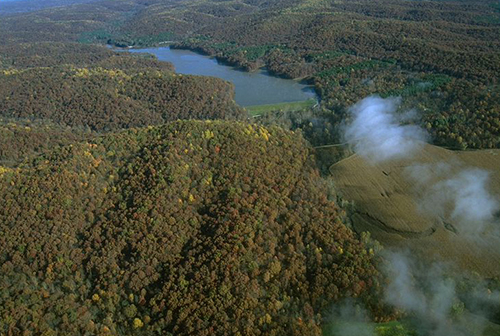Main Content
Article
Timber Harvest at Yellowwood State Forest

The Department of Natural Resources (DNR) has transformed nearly 160,000 acres of once neglected and abandoned farm and forest land into the healthy and diverse forests that exist in Indiana today, including the Yellowwood State Forest’s backcountry.
Forest practice and research shows that periodic timber removal assists in maintaining the overall health of the forest, including managing for endangered species, soil and water protection, sustainable timber, and recreational activities. Learn more about timber harvesting in Indiana State Forests.
The periodic strategic removal of trees in managed harvests opens the forest floor to sunlight, allowing new trees to develop. Logging by single-tree selection, which targets mostly stressed, diseased and declining trees, is part of managing for these conditions in the backcountry area.
DNR’s Division of Forestry is currently leading an effort to harvest select trees from the 299 acres of the Yellowwood State Forest’s backcountry. Single-tree selection will be used, as it has been used in the previous 13 harvests of the now Morgan-Monroe/Yellowwood State Forest backcountry area.
Five to seven trees per acre may be removed during this thinning. The DNR’s forestry division determines the trees to be removed dependent on each tree’s health and impact to the overall forest area.
Studies conducted by independent researchers working on State Forests show that species of conservation concern, such as the timber rattlesnake, hooded warbler, worm-eating warbler and Indiana bat can benefit from conditions created by periodic thinning of the areas like the backcountry’s current closed canopy.
Much inaccurate information has been distributed about the timber harvest in the Morgan-Monroe/Yellowwood State Forest's backcountry area. View maps of the area from 1939 and present .
There are many myths regarding the timber harvest in the Morgan-Monroe/Yellowwood State Forest's backcountry area. The following sets the record straight.
Videos about the Yellowwood timber harvest
- Backcountry Area
- Backcountry Area Harvest
- History of the State Forest
- Tecumseh Trail
- Timber Buying and Best Management Practices
- Wildlife
- Sustainable Forestry
- Hardwood Ecosystem Experiment
Professional organization support
- Congressional Sportsmen’s Foundation
- Forest Management Support Letters
- Society of American Foresters
- Support Letter by Various Groups
- Raoul Moore, Moore Family Tree Farm
- George Parker, Harmon Weeks, Professor Emeritus, Purdue University
- National Wildlife Turkey Federation
Select a myth below to reveal the truth about timber harvesting
- Myth: The timber sale in Yellowwood State Forest “destroys” public land.
- Myth: The backcountry area is a “pristine forest” whose “ecology has been determined by nature, not human beings.”
- Myth: Loggers are going into the heart of the area.
- Myth: At least a few dozen to more than 40 or more trees will be cut on nearly every acre.
- Myth: Logging on steep slopes will erode soil and cause more silt to go into nearby Lake Lemon.
- Myth: The backcountry area contains many “endangered species” that will be harmed by the timber harvesting.
- Myth: This is a rushed decision that deserves more consideration.
- Myth: Logging has increased 400 percent in Indiana’s State Forests.
